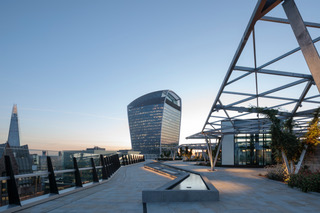Larsen Building Products BS 7533 compliant ECO paving mortar system utilises waste material from another manufacturing process. Before we delve into the detail, let’s look at some interesting facts around cements contribution to the worlds carbon dioxide emissions (CO2), research into partial cementitious replacements & the impact on the environment in terms of CO2 reduction.

Concrete is the most extensively used manufactured material in the world and is only second to water as the most-consumed resource on the planet. The manufacturing process of cement results in a staggeringly bedding mortar for the laying course as described in BS 7533 part 101, PS ECO bonding mortar, required for bound system B as per BS 7533 part 101 & FJM ECO, flowable jointing mortar or slurry grout as per BS 7533 part 101. GGBS is a waste product generated in huge quantities from the steel industries through the manufacture of Iron. Iron ore, coke and limestone are fed into the furnace, the resulting molten slag floats above the molten iron at a temperature of about 1500°C to 1600°C. After the molten iron is tapped off, the remaining molten slag, which consists of mainly siliceous and high emission of greenhouse gases such as CO2. Cement is the source of about 8% of the entire world’s carbon dioxide (CO2) emissions, according to Chatham House and as a result has an immense impact in contributions to global warming. Due to its immense demand, the cost of production of cement is increasing steadily upwards every year as raw materials from natural resources deplete.

Researchers within the cementitious industry have sought to reduce the impact cement has on the environment, whilst maintaining the quality of cementitious products. This research has focused on a search to find a waste material or by-product from manufacturing processes, which can be used as a partial replacement of cement such as Ordinary Portland Cement, OPC, in concrete, without compromising on its desired strength. The most common materials that are pozzolanic and are suitable for use as a partial replacement for cement are Ground Granulated Blast Furnace Slag (GGBS), Fly ash (FA), Rice Husk Ash (RHA), Silica Fume (SF). Larsen Building Products have opted for GGBS as a partial replacement to Ordinary Portland Cement (OPC) in our range of BS 7533 paving mortar products comprising of, FBC ECO permeable bedding mortar for the laying course as described in BS 7533 part 101, PS ECO bonding mortar, required for bound system B as per BS 7533 part 101 & FJM ECO, flowable jointing mortar or slurry grout as per BS 7533 part 101.

GGBS is a waste product generated in huge quantities from the steel industries through the manufacture of Iron. Iron ore, coke and limestone are fed into the furnace, the resulting molten slag floats above the molten iron at a temperature of about 1500°C to 1600°C. After the molten iron is tapped off, the remaining molten slag, which consists of mainly siliceous and aluminous residue is then waterquenched rapidly, resulting in the formation of a glassy granulate. This glassy granulate is dried and ground to the required size, which is known as GGBS. The partial replacement of OPC in concrete by GGBS, not only provides a saving on CO2 production but also facilitates environmentally friendly disposal of the waste slag.

CO2 savings that can be made through the replacement of OPC with GGBS are impressive. E.g., the carbon footprint of Ordinary Portland Cement (CEM II) is 0.803 tonnes CO2/tonne (based on CEMbureau EPD for CEMIIs and National Cement data for EPA license), whereas the carbon footprint for slag (GGBS) is 25 x smaller at 0.032 tonnes CO2/tonne (based on Ecocem Third Party verified EPD). If a percentage of OPC is replaced with GGBS, we can use the average CO2 generated per mile emitted by a car (0.00031 tonnes, ICCT EU Pocketbook 2014) or the number of trees growing for ten years absorbing 1 tonne of CO2 (25 trees) to contextualise the CO2 emissions saved e.g., if 1 tonne of product containing 25% OPC was produced and 20% of the OPC is replaced with GGBS this would be the same as 1 tree growing for ten years or 124 miles not driven.


